Underground Helsinki and Underground Urbanism

Map of Central Helsinki Early 1900’s (Map: Wikipedia)
Although a country with few people and plenty of space, Finland’s capitol city Helsinki being located on a peninsula finds itself constantly constrained for space by the sea. Luckily the city sits above bedrock which is deep and which frequently punctures the ground. So Helsinki has increasingly used its bedrock to tunnel into and create an underground city. Now with over 400 documented underground facilities and 200 more planned, Subterranean Helsinki is probably one of the largest and most comprehensive underground city systems in the world for its size.
Summary
This article is mainly an overview of the way Helsinki is already using it’s underground space. It’s meant as a good reference point for exploring interesting ways to develop an existing fairly low-rise European type city without expanding upward necessarily.
Finnish Rescue Act
The Rescue Act is in many ways the driver for these large multipurpose underground facilities. In Finland any building over 1200 square metres that is permanently occupied must have an emergency shelter built in place. That means the building must provide a place where people can live and shelter for instance in a war or even during a mass pandemic. These spaces almost invariably must therefore be underground and they can otherwise be used during normal times.
Masterplan
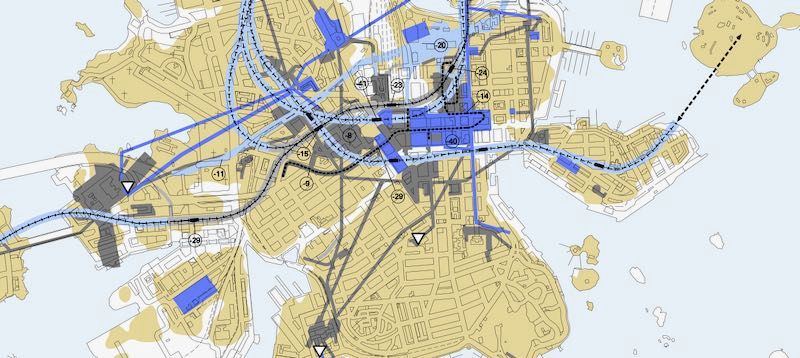
Extract of the Helsinki Underground Master Plan of 2011. Gray= current underground facilities and tunnels, Light Blue= planned future underground tunnels and facilities, Blue =Existing, brown= bedrock resources near the surface suitable for the underground construction
This active use of the space under Helsinki meant that in 2007 the City government published an Underground Masterplan to further help develop opportunities to utilise the subterranean space.
There are underground churches, gyms, ice hockey pitches, running tracks, water processing plants, shopping malls, bus stations, the list goes on and on.
The Underground Masterplan acts as a way for the city to coordinate the strategy for development of Underground Helsinki and it will be renewed in 2020. The new plan hopes to assist with the overall desire for Helsinki to densify and so the underground city will again expand and diversify.
Probably the best known underground areas are around Central Station which is home to a network of metro stations shops and tunnels that connect much of the city centre together and allow you to arrive and walk below the centre of the city without surfacing at all.
Also because when new facilities are built they are connected back into the existing underground system it expands out like the roots of a tree. A good example of this is round Kaisaniemi metro which links underground station with shopping mall within an existing building that joins up to an atrium made from a filled in urban block which in turn links through to an underground cinema. Here the underground city tunnels back into the urban fabric above ground also.
I think this is one of the most impressively urban things about Helsinki which otherwise is a quite centrally planned and unobtrusive small city. This ‘deep urbanism’ is where Helsinki distinguishes itself as being different, and the fact that the city has an official underground city plan reflects this attitude to some degree.
The bedrock quality in Finland is, for the most part, ideal for tunnelling and building underground spaces since the bedrock mainly consists of old Precambrian rocks
(Finnish Tunnelling Association, 1997)
Some general Statistics about Helsinki Underground city
- Over 400 Separate facilities
- Total tunnels length 293km
- 194 km of technical tunnels
- 34 km of traffic tunnels
- 30 km of tunnels with secondary purpose as emergency shelters
- 14 km of parking caverns
- 22 km of tunnels for other purposes
Ref. (Pehkonen, 2017 and Vähäaho, 2012) from Urban Underground Space Sustainable Property Development in Helsinki
Underground Development Strategies
A good example of the way Underground space can be developed is under Katri Vala Park in the city center which below it has four separate underground developments.
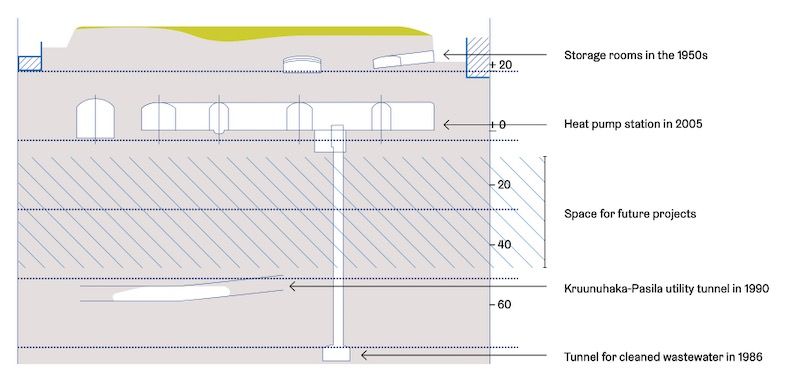
0-land-use example. (Image:City of Helsinki)taken from Urban Underground Space - Sustainable Property Development in Helsinki
This stacking of different programs perhaps independently owned and operated is called 0-land-use. Demonstrated below Katri Park, shows the layering underground developments can add to land use. It also raises some questions about land ownership, in theory anyone who owns the land above also owns it below but these may be mitigated by zoning and planning agreements. In central Helsinki many older properties have basements up to 6m underground with metro and service facilities already built then this layering will only become more common.
Below I have compiled a list of some of the larger key underground public structures in Helsinki.
Public Underground
Central Station underground
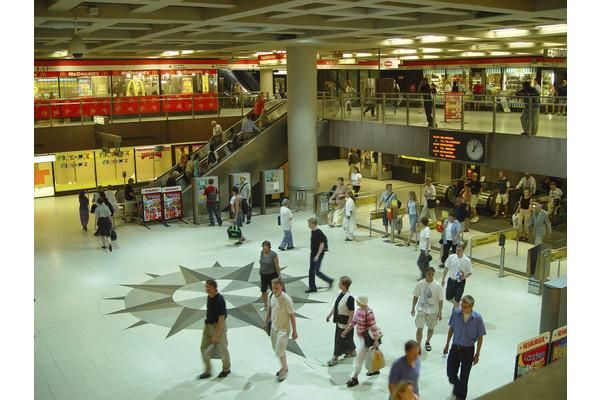
Asematunneli (Photo: Helsinki City)
The underground area centred around the Central Station area (Asematunneli) is the largest interconnected underground system in Helsinki which is also open to the public. It joins the main train station, metro line with shops both there and connected by tunnels.It connects into several large parking halls and also into the Kehu service tunnel which allows service vehicle to drive right through the Center of Helsinki. You can walk central Helsinki in this underground zone and probably spend a day there without going outside.
Temppeliaukio Church
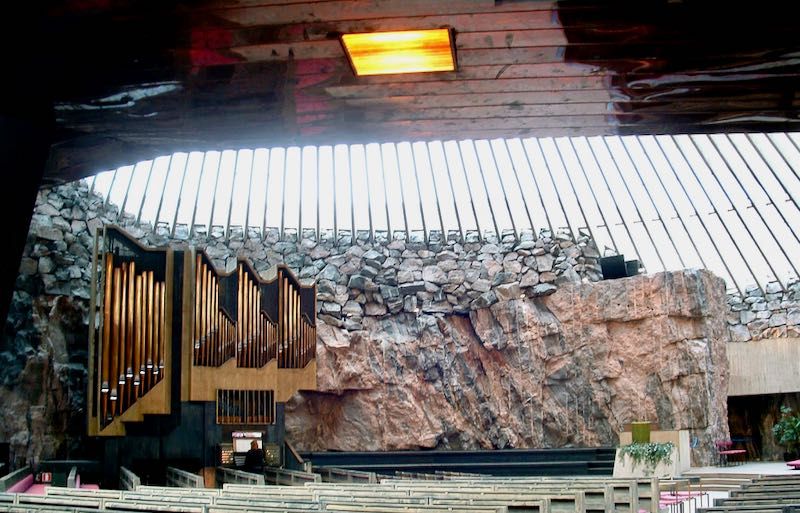
Temppeliaukio Church
Architects Timo and Tuomo Suomalainen won the competition to design a church in the old town of Helsinki in a site surrounded by apartment buildings. Their proposal was to partially bury the church as the site was a rocky outcrop. The Temppeliaukio Church was finished in 1969 and is one of the better modern buildings in a city which is full of them. The sides of the church let water through on purpose when it rains allowing for natural water flows down the side of the church. It’s a must visit for any tourist to Helsinki.
Amos Rex Art Gallery
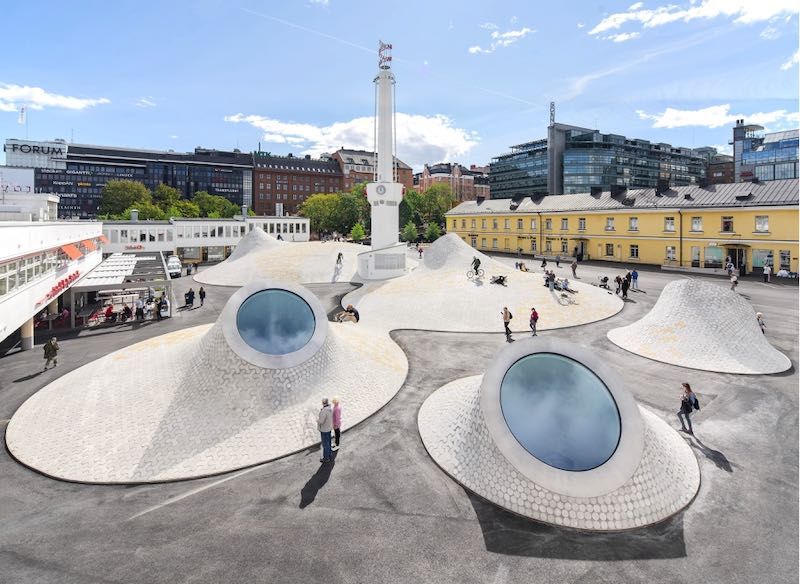
Amos Rex from above (Photo: JKMM website)
Completed in 2018 the Amos Rex Art Gallery is a major gallery space for the largest private collection in Finland and its almost entirely underground. The entrance is in the Lasipalatsi a 1930’s functionalist building originally meant as a temporary building but now protected. The location is perfect for downtown Helsinki but there was too little space. The solution was to put all the galleries underground. The Architects JKMM added roof lights to provide natural diffuse light into the main galleries and make a new square above with the curved domed treatment of the rooflights.
Itäkeskus underground swimming centre
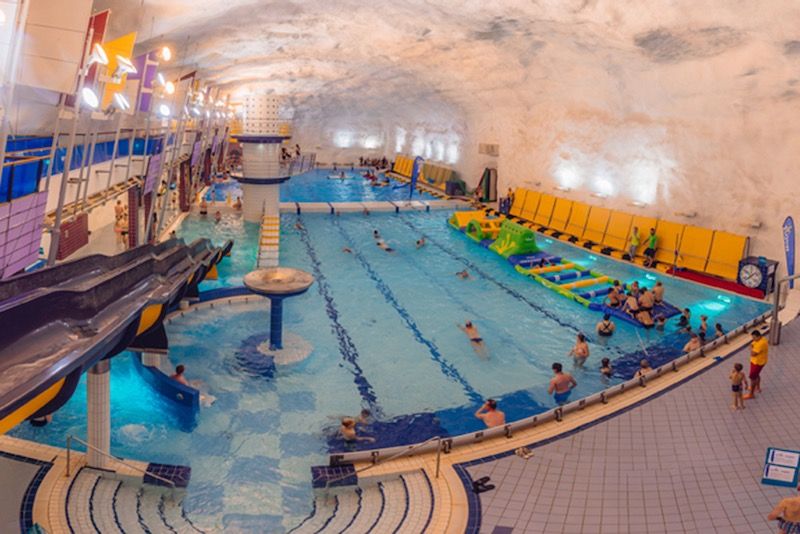
Itäkeskus Swimming Centre Photo:City of Helsinki
Itäkeskus underground swimming centre was carved from the bedrock in 1993. The spa-type underground space contains a 50-metre swimming pool, whirlpool baths, saunas, a gym, etc. The facility can be converted into a shelter for 3,800 persons.
Western metro expansion
Helsinki Metro system is the northernmost in the world. The first set of stations opened in 1982 and Länsimetro or Western Metro opened in 2017. It is a13.9-km long fully underground twin tunnel Metro extension for Helsinki into the neighbouring suburb of Espoo with eight new stations. The next phase is being built with five additional stations along the Lansimetro route.
Airport Ring Rail Line
An underground Ring Rail Line (Kehärata) connects Helsinki Airport, next door Aviapolis commercial district with the Helsinki rail network. The 18 km long line was finished in 2015.
Services
Helsinki is developing also a really interesting diverse energy and services infrastructure that they can increasingly make carbon neutral. Below is a short overview of some of the key projects.
Underground Energy System
Helsinki already has a district heating and cooling system. This system is supported by a massive underground tunnel network of more than 40 km of multi-utility tunnels. But Helen Helsinki’s energy company is always looking at ways to improve and expand the system.
An old underground fuel store in Mustikkamaa has been converted for use as a storage facility for district heat. It stores 260 billion cubic litres of warm water to be used in the winter by heat pumps.
A more ambitious project is proposed in an underground facility in Kruunuvuori in the center of Helsinki. The oil company Shell excavated two massive rock caverns 50m under Kruunuvuori in the 70’s (300,000 cubic metres) and these are now unused. Helen has proposed a seasonal energy storage system there whereby warm seawater (about 300 million litres) in the summer is pumped into the caverns, in the winter the warm sea water is used as a source of energy for the heat pumps in the district heating system.
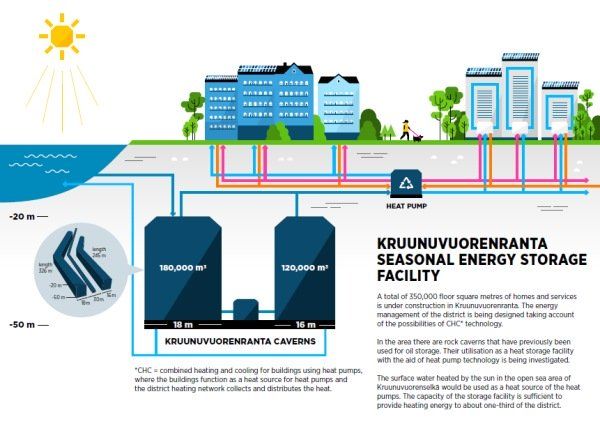
Kruunuvuoren heat storage concept. Showing water pumped from the Baltic in the Summer to act as a heat store during Winter. (Image:Helen Oy)
Viikinmäki underground wastewater treatment plant


Helsinki Water has centralised all of its wastewater treatment operations into the Viikinmäki wastewater treatment plant. The total volume of excavated rock was 1,200,000 m3. The first phase (1,000,000 m3) was excavated in 1988-91 and the second phase (200,000 m3) in 2000-01. It replaced ten smaller waste water treatment plants which were all above ground. This enabled Helsinki planners to plan for 3500 inhabitants in the residential area above the tunnels.
Otaniemi - underground spaces
Over 50 underground spaces, including the national film archives, the underground shelters of the Dipoli conference centre and VTT Technical Research Centre of Finland, Helsinki University of Technology campus area connection tunnels, Laboratory of Rock Engineering test tunnel, etc.
KEHU - Helsinki Service tunnel
2.5-km service tunnel across the city, from east to west, under the historical centre of Helsinki. The tunnel is used to service shops, restaurants, offices and hotels in the area. Service trucks no longer have to clog up the streets above freeing up to be more pedestrian and bike friendly.
Other Underground Spaces
Below is a list of a few of the other underground spaces;
Formula Center Helsinki
In Eastern Helsinki opened in 1995 is possibly the only subterranean karting track in the world.
Päijänne Water Tunnel
The Worlds’ second longest continuous Rock Tunnel (120 km) which brings fresh water from Lake Päijänne to Helsinki.
Hartwall Arena
Subterranean full size ice hockey hall 31m wide allows the ice hockey team to practise year round.
Suomenlinna Tunnel
Suomenlinna is an island off of Helsinki on which there is a Sea Fortress built by the Swedish and expanded by the Russians. The island is connected underground by a service tunnel. The tunnel is 1300m long and 4m wide and high it means an emergency vehicle can get to the island. It also supplies the island with district heating, water, sewage, electricity, and data.
Flexibility and Resiliency
The fact that Helsinki has a well developed underground structure which it is continuously growing means the city can plan for greater flexibility and resiliency going forward.
For example the Central Hospital in Helsinki was able to convert its underground parking facility into a temporary ward for COVID patients at short notice allowing for it to find other buildings in the longer term.
Its energy plans make use the earths heat and its location by the sea to deliver increasingly carbon neutral energy solutions with the city panning to be Carbon Neutral by 2035. The Underground public sphere is slowly expanding to allow better and quicker access around the city.
A city that digs down can densify without becoming taller, it can spread and ease congestion and it can hug the earth to help provide warmth even grow crops.

Underground food growth in Callio (photo: CallioLab)
In Finland the Callio project is looking at the different ways to exploit the now mostly closed Pyhäsalmi mine in the town of Pyhäjärvi. At 1450m deep the mine is the deepest base metal mine in Europe. At 660m below ground the Callio project began growing hops with the desire to see whether the possibility of year round food production could take place deep underground. This strategy if successful could be brought right underneath the city.
Resilient Cities
Talk with inevitably rise during 2020 for planning to make cities more resilient and less dependant on external supply chains part of that can come from flexibility in the use of its infrastructure and with solutions from building underground.
Further Reading:
Helsinki Urban Underground Spaces: Guideline for visitors (pdf)
Urban Underground Space: Sustainable Property Development in Helsinki (pdf)